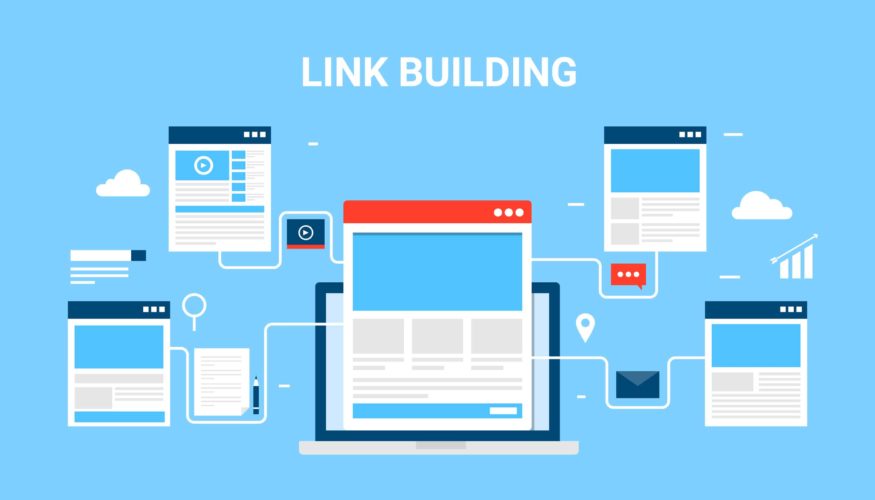Links are the currency of the web. The websites that have plenty of them are deemed “authoritative” and are rewarded with high rankings in Google. While websites that don’t have any are bound to obscurity.
If you’re just starting out in SEO, figuring out link building can be quite a challenge.
Some SEOs will tell you to create great content and wait for links to come naturally, others will insist that strategic link prospecting and targeted email outreach is where it’s at, and someone else will give you a cryptic smile and drop just one word: PBNs.
So who should you listen to?
As with many things in SEO, the correct answer is: “it depends.” There’s no single right approach to link building and your choice of tactics will largely depend on your industry, your website, your resources, and your goals.
Did I just make things even more confusing than they already were?
Worry not. We created this link building guide with absolute beginners in mind and made sure that it’s full of actionable advice that you can start implementing right away.
So let’s begin, shall we?
Chapters
Chapter 1: Link building basics
What is link building?
Link building is the process of getting other websites to link to pages on your website to help them rank higher in Google search results.
In general, you can boil most “white hat” link building strategies down to two simple steps:
- Create something notable (and therefore worthy of a link);
- Show it to people who own websites (and thus can link to it).
Why is link building important?
According to Google’s Andrey Lipattsev, links are one of the three major ranking factors in Google. So if you want your website’s pages to rank high in search, you will almost certainly need links.
As a general rule, pages with more backlinks tend to rank higher in search results. This has been studied at scale by many SEO companies and the correlation between the number of websites linking to a page and it’s ranking position in Google has always turned out positive.
Links aren’t the answer to everything
Other than all links not being equal (we’ll talk more about it in Chapter 3), search engines factor in many other variables when ranking pages. And the mix of these variables may actually depend on the type of search query that you want to rank for.
So if you build lots of links to your page and it still ranks poorly, don’t blame this guide for misleading you. Look into other ranking factors that might prevent you from ranking well.
Chapter 2: How to build links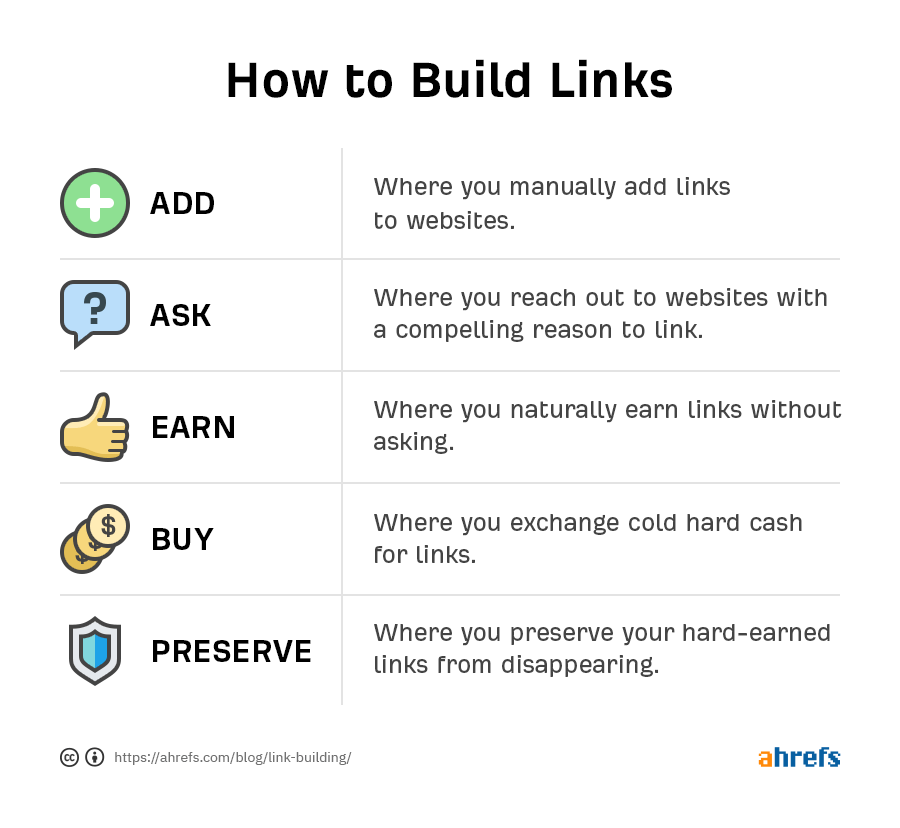
1. Add links
If you can go to a website that doesn’t belong to you and manually place your link there, that’s called “adding” a link. The most common tactics that fit into this category are:
- Business directory submissions;
- Social profile creation;
- Blog commenting;
- Posting to forums, communities & Q&A sites;
- Creating job search listings;
- etc.
Building links via those tactics is very easy to do. And for that exact reason, those links tend to have very low value in the eyes of Google (and in some cases can even be flagged as SPAM).
Other than that, these kinds of links barely give you any competitive advantage. If you can go to a website and manually place your link there, nothing stops your competitors from doing the same.
However, you shouldn’t ignore this group of link building tactics entirely. Each of them can actually be quite beneficial for your online business for reasons other than acquiring links.
2. Asking for links
As the name suggests, this is when you reach out to the owner of the website you want a link from and give them a compelling reason to link to you.
Here are some of the link building tactics and strategies that fall into this category, along with a briefly defined “compelling reason” that they’re based off:
- Guest blogging — create useful content for their website;
- Skyscraper technique — show them a better resource than the one they’re linking to;
- Link inserts — show them a resource with more information on something they’ve briefly mentioned;
- Ego bait– mention them or their work in your own content in a positive light;
- Testimonials & Case studies- give positive feedback about their product or service;
- Link exchanges — offer to link back to them if they agree to link to you;
- Resource page link building– show them a good resource that fits their existing list;
- Broken link building– help them fix a “dead” link on their page;
- Image link building– ask to get credit for using your image;
- Unlinked mentions– ask to make the mention of your brand “clickable;”
- Link moves — ask to make changes to an existing link;
- HARO (& journalist requests) — give an “expert quote” for their article;
- PR– give them a killer story to cover;
3. Buying links
Let’s get this straight from the get go: we don’t recommend that you buy links!
At best, you’re likely to waste lots of money on bad links that will have zero impact on your rankings; at worst, you’ll get your website penalized.
However, we would be putting you at a disadvantage if we didn’t disclose the fact that many people in the SEO industry “buy” links in all sorts of ways and manage to get away with it.
That said, we won’t teach you how to buy links safely, but rather educate you on some of the riskiest ways to do it.
- Private blog networks
- Fiverr
- Link seller SPAM
4. Earning links
You “earn” links when other people link to the pages on your website without you having to ask them to do so. This obviously doesn’t happen unless you have something truly outstanding that other website owners would genuinely want to mention on their websites.
But people can’t link to things that they don’t know exist. So no matter how awesome your page is, you’ll need to invest in promoting it. And the more people see your page, the higher the chance that some of them will end up linking to it.
Here are a few tactics and strategies that fall into this category:
- Linkbait (or linkable assets);
- Data studies, infographics, maps, surveys, awards;
- Podcasts / interviews / expert roundups;
- Content promotion;
- etc.
5. Preserving links
As the name suggests, this final group of tactics is focused around preserving all your hard-earned links. One might argue that reviving your lost links can’t be categorised as “link building.” But as they say, “a dollar saved is a dollar earned.”
There are just two ways of preserving links:
Chapter 3: What makes a good link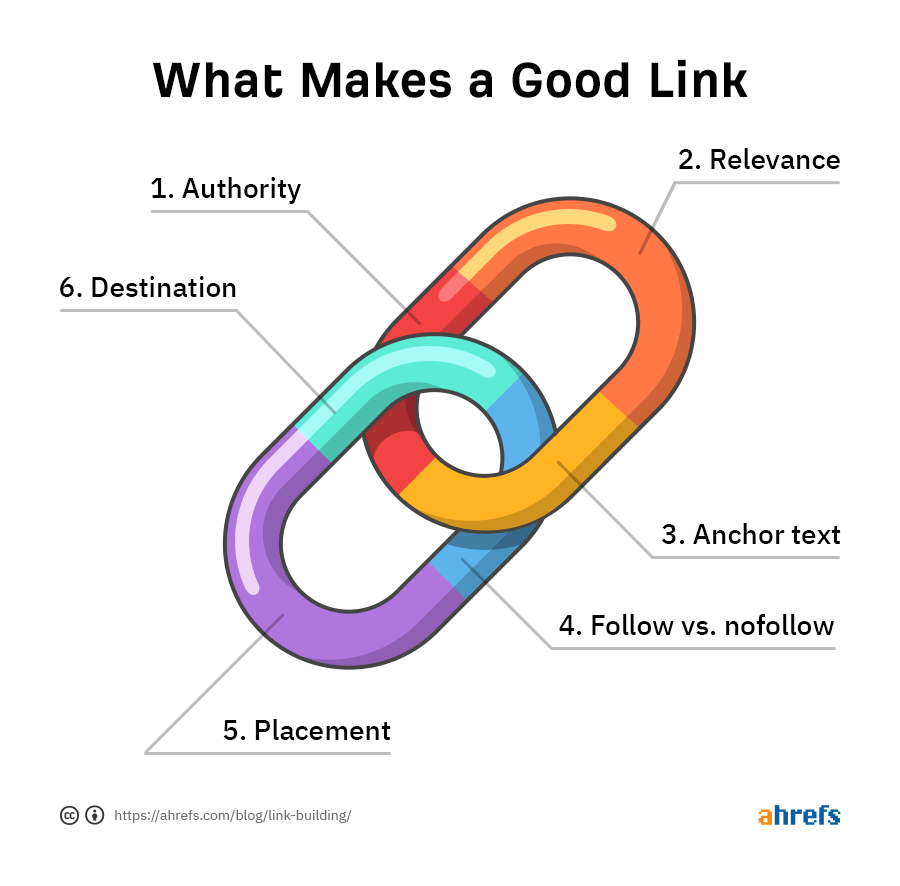
Nobody knows for sure exactly how Google measures the value of each link. But there are some general concepts of evaluating links that the SEO community believes to be true.
1. Authority
So how does Google measure the “authority” of a website (or a webpage) that is linking to you? Well, if links are votes, then it would be fair if a page that has more votes would cast a stronger vote to other pages, right? 
And that is actually one of the main principles behind the PageRank algorithm, which Google’s founders Larry Page and Sergey Brin conceived back in 1996.
There also used to be a browser plugin that displayed the PageRank score of any webpage on a scale from 0 to 10. But somewhere around 2014 Google discontinued it, leaving the SEO community wondering how much “authority” they assign to each web page.
Luckily, many SEO tool providers have developed their own link-based authority metrics, which are based on some of the same principles used in the original PageRank algorithm.
The authority metrics that we have here at Ahrefs are Domain Rating (DR) and URL Rating (UR). Both are measured on a scale from 0 to 100.
2. Relevance
3. Anchor text
Just in case you’re not already familiar with the term, “anchor text” is a clickable snippet of text that sends you to another page.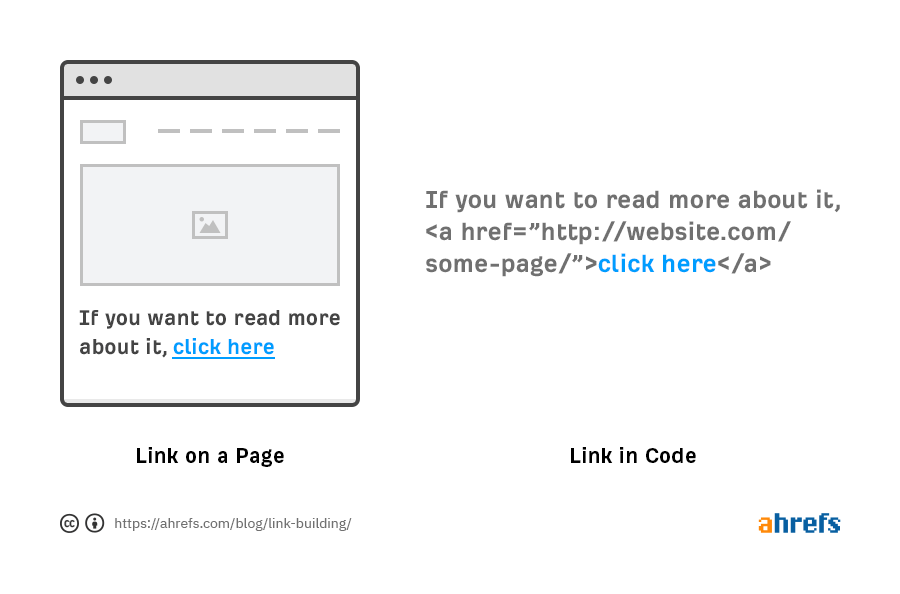
So how do you leverage anchor text when building links?
Well, you don’t. The more you try to control how different pages link to you and shoehorn all the “right words” into the anchor texts of your backlinks, the higher the chance that Google will penalize you for that.
And besides, most white-hat link building tactics give you little to no control over the anchor text, which only prevents you from shooting yourself in the foot.
4. Nofollow vs follow
“Nofollow” is a link attribute that tells Google the linking page would rather notgive its vote to the page that it is referencing.
Here’s how this link attribute looks in the HTML code:
Historically, Google didn’t count votes from ‘nofollowed links’ (or so they said). Then, in 2019, they switched to a hint model, which means that some ‘nofollowed’ links may now influence your search rankings.
They also introduced two new link attributes at with this announcement:
- rel=“UGC” — should be applied to “user generated” links, e.g., blog comments and forum posts.
- rel=“sponsored” — should be applied when the link is part of an advertisement, sponsorship, or some other compensation agreement.
As a general rule, you want to be building “followed” links (i.e., links that don’t have any of the aforementioned attributes), because these are the ones that are supposed to cast votes.
However, if you see an opportunity to get a nofollowed link from a relevant high-authority page, you should absolutely do it.
A good example is Wikipedia where all outgoing links are nofollowed. Getting a link from Wikipedia is incredibly hard, which is why many SEOs are convinced that those links are quite valuable in the eyes of Google.
5. Placement
Google’s reasonable surfer patent talks about how the likeliness of a link being clicked may affect how much authority it transfers. And placement of a link on a page is one of the few things that can affect its CTR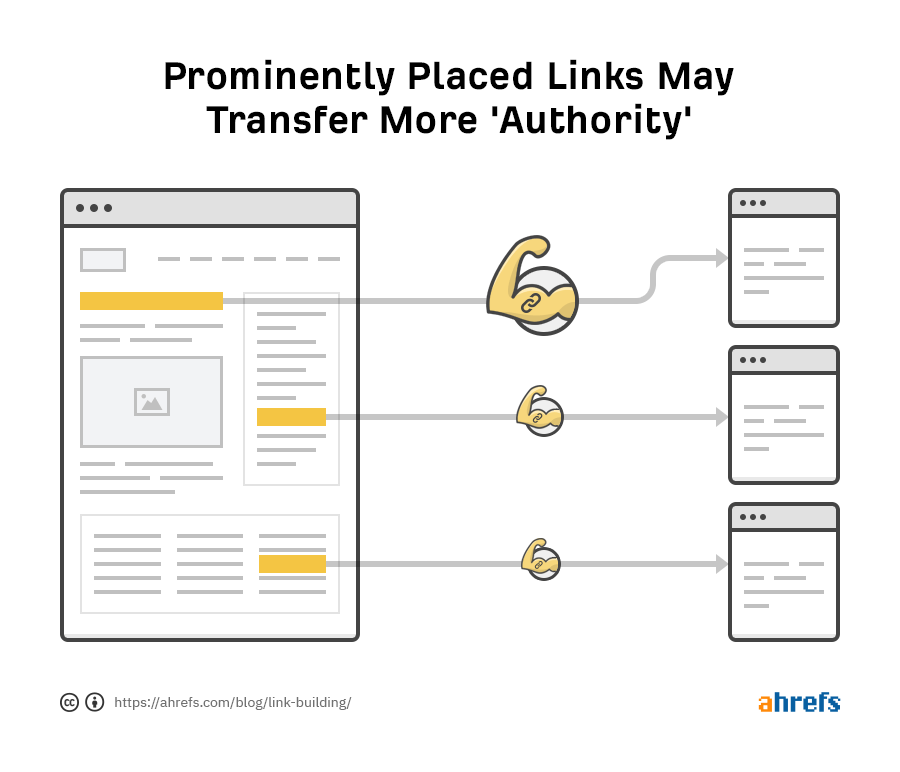
Just like with anchor text, most white-hat link building strategies give you little to no control over the placement of the link.
But if you’re writing a guest article for someone else’s blog, you should definitely try to entice readers to click on your links. Not just for boosting the SEO value of those links, but because it will also send some nice referral traffic your way.
6. Destination
When building links to your website, there are three destinations where you can point them:
- Your homepage;
- Your linkable assets;
- The pages that you actually need to rank high in Google.
In other words, build as many links as you can to your linkable assets and funnel all that “link juice” towards the pages that you actually want to rank via internal links.
And keep in mind that things like placement, relevance and anchor text affect the value of your internal links too.
Chapter 4: Best link building tactics
1. Pursuing competitor’s links
Competitor link research is one of the most fundamental activities in link building. Think about it, the top-ranking page for your desired search query has all the right links which persuaded Google of its superiority. By studying its links you can figure out which tactics to use so that you can get similar links and outrank that page.
From here your course of action is two-fold:
- Try to get links from the pages that link to your competitors;
- Study how those links were acquired and use what you learn to find other similar pages to get links from.
2. Creating linkable assets
It’s possible to build links to any page with enough willpower and determination, but life is easier when you have something that people actually want to link to.
When talking about linkable assets people tend to think of very specific things like:
- Online tools & calculators;
- Infographics, GIFographics & “Map-o-graphics;”
- Awards & rankings;
- Studies & research;
- “How to” guides & tutorials;
- Definitions & coined terms;
3. Content promotion
No matter how “linkable” your pages are, people can’t link to them without first discovering them. In other words, even the best linkable assets have to be promoted in order to attract links.
Chapter 5: Link building tools
While it is technically possible to build links with just a bit of brain power and an email account, there are a number of link building tools that will help make the process of acquiring links much easier.
Let’s review four kinds of tools that might help you with building links:
1. Backlink research tools
As you already know, studying the links of your competitors is extremely helpful when developing an actionable link building strategy for your own website.
Ahrefs’ Site Explorer is widely regarded as the industry’s favourite backlink research tool.
2. Content research tools
Content research tools take the guesswork out of creating shareable, link-worthy content. You can use them to find content angles that have generated lots of links and shares, and leverage those findings to create your own content.
Ahrefs’ Content Explorer runs on a huge index of over five billion pages and helps you easily discover noteworthy content in any industry.
3. Web monitoring tools
Web monitoring tools alert you of newly-published pages that mention your keyword, or new backlinks that your competitors have acquired. Both of these alerts can serve as a great source of link building opportunities.
Ahrefs Alerts does a pretty good job with both kinds of alerts: backlinks and keyword mentions.
4. Email outreach tools
Email outreach tools help you manage and track link building campaigns. They also simplify the process of finding prospects, creating outreach templates, sending follow-ups, and more.
There are plenty of options to choose from but the right tool for you will depend on your tactics and processes, scale of operations, and budget.
We asked our Facebook community for their favorites and here’s what we got

A few interesting email outreach tools that weren’t mentioned by our community are Neverbounce and Clearout.io.

